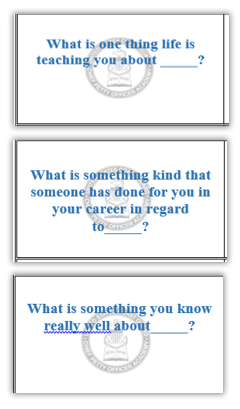If the thought of hosting a leadership development discussion at your unit leaves you feeling tongue-tied, it might be time to check out the Office of Leadership’s (CG-128) new Leadership Competency Facilitator Guide.
The guide and job aid helps employees become leaders in the Coast Guard. Four staff members at the Chief Petty Officer Academy (CPOA) initially created the guide to help students deepen their learning by having them draw on and share real life experiences. The method has been so successful, it has now been repurposed to help the workforce develop any of the 28 competencies laid out in the updated Coast Guard’s Leadership Development Framework that was released in June.
“After the launch of the updated policy in June, we heard the workforce’s feedback asking for a tangible way to engage with the Leadership Development Framework, and it was important for us to provide that kind of tool,” said Lt. Merrill Gutowski, officer and civilian leadership course manager. “The CPOA instructors are experts in taking big leadership concepts and making them accessible and relatable to anyone.” 
The guide contains 50 questions that can be mixed and matched with any of the leadership competencies to begin a discussion. The questions are printed on coaching cards that the facilitator can cut apart and hand out to participants. These prompts draw on your life experiences as opposed to what you’ve been taught about a subject, so everyone has a chance to get involved.
For example, let’s say you were doing a session on how to influence people. Your prompt might ask: What’s the best, worst, or funniest story you have about influencing others? Meanwhile, your discussion partner could get the question: What would you do differently about influencing others if no one would judge you? Later, the group would come back together to debrief on what you’d all learned.
“The idea is to get you to think more deeply and review past experiences, reshape them, and share them” said Master Chief Petty Officer Glenn T. Royes, who oversaw the creation of the guide along with Senior Chief Petty Officers Jacob Zorbaugh, Rebecca Newell, and Chief Petty Officer Keith Impey.
This approach is based on the theory that you need to create an experiential learning environment in order for adult learners to truly change their behavior. Ideally, participants will benefit from sharing their experiences, knowledge and reflecting on what they’ve heard. At the beginning of the exercise, facilitators are told to instruct participants on how they should listen.
Royes envisions leaders using the questions as they introduce the LDF to small groups, whether that means civilian teams or the Chief’s Mess on a cutter conducting preventive maintenance on the mess deck. He sees it as a fresh take on the LDF that aligns with the Commandant’s strategy to approach training in a different way.
“Hopefully,” he said, “it sets the stage for a fun informal learning experience centered on leadership and what the Coast Guard desires from our leaders.”
Resources:
In the News: